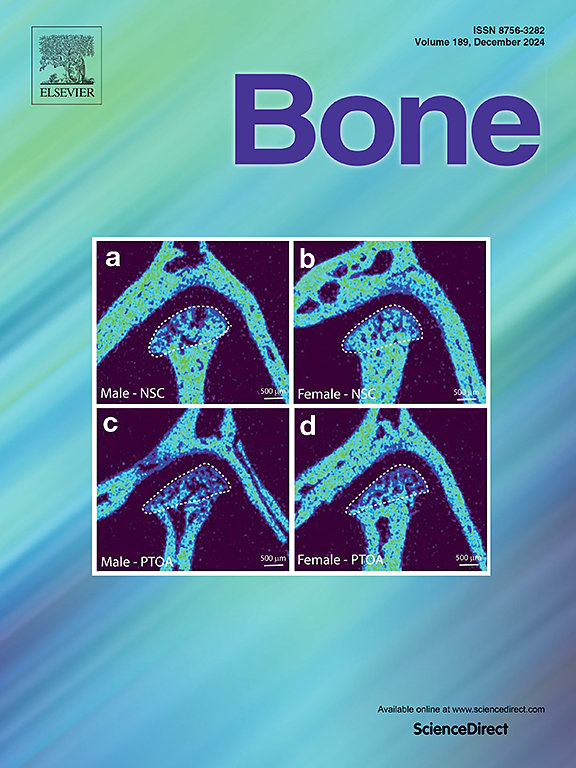Automatic segmentation of cortical bone microstructure: Application and analysis of three proximal femur sites
IF 3.5
2区 医学
Q2 ENDOCRINOLOGY & METABOLISM
引用次数: 0
Abstract
Osteoporosis is the most common bone metabolic unbalance, leading to fragility fractures, which are known to be associated with structural changes in the bone. Cortical bone accounts for 80 % of the skeleton mass and undergoes remodeling throughout life, leading to changes in its thickness and microstructure. Although many studies quantified the different cortical bone structures using CT techniques (3D), they are often realised on a small number of samples. Therefore, the work presented here proposes a method to quantify cortical bone microstructure using 2D histology, shows its application on a set of 94 samples and compares to 3D methods.
Fresh frozen human femur pairs from 47 donors aged between 57 and 96 years were obtained from the Medical University of Vienna. Bone samples were cut from 3 sites: proximal part of the diaphysis, inferior and superior segments of the neck. The samples were stained with toluidine blue and imaged under light microscopy. After manual segmentation of a few regions of interest by multiple operators, a convolutional neural network was trained in combination with a random forest for automatic segmentation. The segmentation analysis compares morphology and structure distribution of Haversian canals, osteocyte lacunae, and cement lines with literature, between anatomical sites, sex, left and right sides, and relation to ageing.
Morphological analysis of the segmentation gives results similar to the literature. Comparison between male and female donors shows no significant differences. There is no significant difference between left and right femur on paired samples but significant differences are observed between anatomical locations. The structures' relative amounts do not present significant changes with age but only weak tendencies. Nevertheless, a strong correlation was observed between osteocyte lacunae density and bone areal fraction.
This study presents a full process to stain and automatically segment digital cortical bone images. Its application to a large sample set of proximal femora provides strong statistics on the cortical bone structures morphology and distribution. Similarities observed between sides and sexes together with differences observed between sites could indicate that mechanical loading might be a main driver for bone microstructure. Additionally, the relationship between osteocyte lacunae density and bone areal fraction could suggest that bone porosity is regulated by osteocyte survival.

皮质骨微结构的自动分割:股骨近端三个部位的应用与分析。
骨质疏松症是最常见的骨代谢失衡,导致脆性骨折,已知与骨结构变化有关。皮质骨占骨骼质量的80% %,并在一生中经历重塑,导致其厚度和微观结构的变化。尽管许多研究使用CT技术(3D)量化了不同的皮质骨结构,但它们通常是在少量样本上实现的。因此,本文提出了一种利用二维组织学定量皮质骨微观结构的方法,展示了其在94个样本上的应用,并与三维方法进行了比较。从维也纳医科大学获得了来自47名年龄在57岁至96岁 之间的捐赠者的新鲜冷冻人类股骨对。从3个部位取骨标本:骨干近端、颈部下段和上段。用甲苯胺蓝染色,光镜下成像。在多个算子对一些感兴趣的区域进行人工分割后,结合随机森林训练卷积神经网络进行自动分割。分割分析比较了哈弗氏管、骨细胞腔隙和水泥线在解剖部位、性别、左右两侧的形态和结构分布以及与衰老的关系。对分割的形态学分析得到了与文献相似的结果。男性和女性捐赠者之间的比较没有显着差异。配对样本的左右股骨无显著差异,但解剖位置之间存在显著差异。随着年龄的增长,结构的相对数量没有明显的变化,只有微弱的变化趋势。然而,骨细胞腔隙密度与骨面积分数之间存在很强的相关性。本研究提出了一种对数字骨皮质图像进行染色和自动分割的完整过程。它在股骨近端大样本集上的应用,为皮质骨结构形态和分布提供了强有力的统计数据。在侧面和性别之间观察到的相似性以及在部位之间观察到的差异可能表明机械载荷可能是骨微观结构的主要驱动因素。此外,骨细胞腔隙密度与骨面积分数之间的关系可能表明骨孔隙度受骨细胞存活的调节。
本文章由计算机程序翻译,如有差异,请以英文原文为准。
求助全文
约1分钟内获得全文
求助全文
来源期刊

Bone
医学-内分泌学与代谢
CiteScore
8.90
自引率
4.90%
发文量
264
审稿时长
30 days
期刊介绍:
BONE is an interdisciplinary forum for the rapid publication of original articles and reviews on basic, translational, and clinical aspects of bone and mineral metabolism. The Journal also encourages submissions related to interactions of bone with other organ systems, including cartilage, endocrine, muscle, fat, neural, vascular, gastrointestinal, hematopoietic, and immune systems. Particular attention is placed on the application of experimental studies to clinical practice.
 求助内容:
求助内容: 应助结果提醒方式:
应助结果提醒方式:


